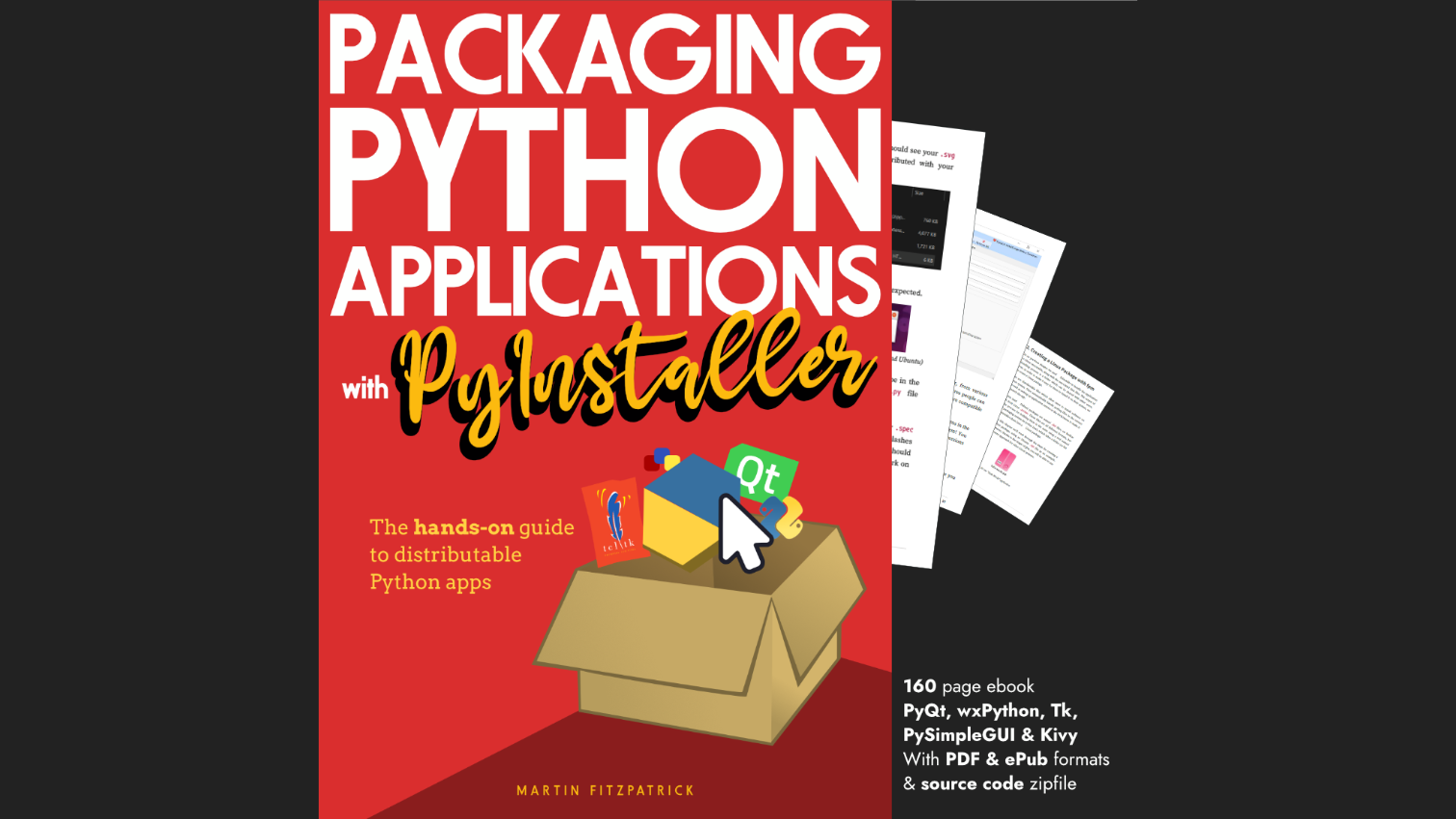PyQtConfig: a simple API for handling, persisting and synchronising configuration within PyQt applications. This module was built initially as part of the Pathomx data analysis platform but spun out into a standalone module when it became clear it was quite useful.
This post gives a brief overview of the API features and use. It is still in development so suggestions, comments, bug reports and pull-requests are very welcome.
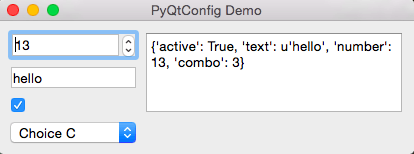
Features
- consistent interface to read values from widgets, always
getandset - seamlessly handle conversion of types from QSettings strings
- integrated mapping handles conversions between display and internal settings, e.g. nice text in combo boxes to integer values
- save and load configuration via
dict(to JSON) orXML - open source and BSD licensed
Introduction
The core of the API is a ConfigManager instance that holds configuration settings (either
as a Python dict, or a QSettings instance) and provides standard methods to get and set
values.
Configuration parameters can have Qt widgets attached as handlers. Once attached the widget
and the configuration value will be kept in sync. Setting the value on the ConfigManager will
update any attached widgets and changes to the value on the widget will be reflected immmediately
in the ConfigManager. Qt signals are emitted on each update.
Default values can be set and will be returned transparently if a parameter remains unset. The current state of config can be saved and reloaded via XML or exported to a flat dict.
A small application has been included in PyQtConfig to demonstrate these features (interaction with widgets requires a running QApplication). Go to the pyqtconfig install folder and run it with:
Create GUI Applications with Python & Qt6 by Martin Fitzpatrick — (PyQt6 Edition) The hands-on guide to making apps with Python — Over 10,000 copies sold!
python -m pyqtconfig.demo
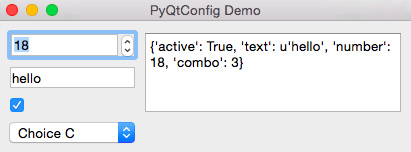
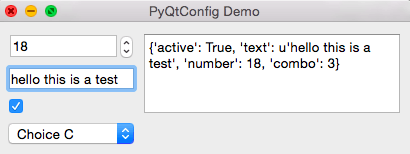
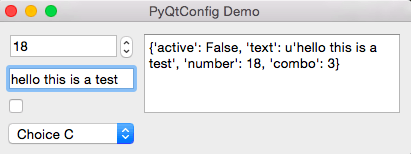
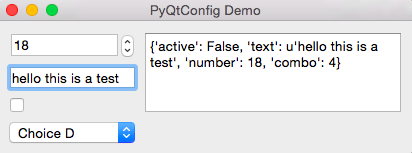
Simple usage (dictionary)
To store your settings you need to create a ConfigManager instance. This consists of a
settings dictionary, a default settings dictionary and a number of helper functions to
handle setting, getting and other functions.
from pyqtconfig import ConfigManager
config = ConfigManager()
config.set_defaults({
'number': 13,
'text': 'hello',
'array': ['1','2'],
'active': True,
})
Before values are set the default value will be returned when queried.
config.get('number')
13
config.set('number', 42)
config.get('number')
42
Simple usage (QSettings)
The QSettingsManager provides exactly the same API as the standard QConfigManager, the
only difference is in the storage of values.
from pyqtconfig import QSettingsManager
settings = QSettingsManager()
settings.set('number', 42)
settings.set('text', "bla")
settings.set('array', ["a", "b"])
settings.set('active', True)
settings.get('number')
>> 42
On some platforms, versions of Qt, or Qt APIs QSettings will return strings for all values
which can lead to complicated code and breakage. However, PyQtConfig is smart enough to
use the type of the config parameter in defaults to auto-convert returned values.
However, you do not have to set defaults manually. As of v0.7 default values are auto-set when attaching widgets (handlers) to the config manager if they're not already set.
From this point on we'll be referring to the ConfigManager class only, but all features
work identically in QSettingsManager.
Adding widget handlers
So far we could have achieved the same thing with a standard Python dict/QSettings object. The real usefulness of PyQtConfig is in the ability to interact with QWidgets maintaining synchronisation between widgets and internal config, and providing a simple standard interface to retrieve values.
It's difficult to demonstrate the functionality since you need a running QApplication to make it work, and you can't do that in the interactive interpreter. The examples that follow are contrived outputs that you would see if it were possible to do that. For a real example, see the demo included in the package.
lineEdit = QtGui.QLineEdit()
config.add_handler('text', lineEdit)
checkbox = QtGui.QCheckBox('active')
config.add_handler('active', checkbox)

The values of the widgets are automatically set to the pre-set defaults. Note that if we hadn't pre-set a default value the reverse would happen, and the default would be set to the value in the widget. This allows you to define the defaults in either way.
Create GUI Applications with Python & Qt6 by Martin Fitzpatrick — (PySide6 Edition) The hands-on guide to making apps with Python — Over 10,000 copies sold!
Next we'll change the value of both widgets.
We can read out the values of the widgets via the ConfigManager using the standard get interface
rather than using the widget-specific access functions.
config.get('text')
>> 'hello'
config.get('active')
>> True
We can also update the widgets via the ConfigManager using set.
config.set('text', 'new value')
config.set('active', False)

Mapping
Sometimes you want to display a different value in a widget than you store in the configuration. The most obvious example would be in a combo box where you want to list nice descriptive names, but want to store short names or numbers in the configuration.
To enable this PyQtConfig allows a mapper to be defined when attaching a widget to a config.
Mappers are provided as tuple of 2 functions set and get that each perform the conversion
required when setting and getting the value from the widget. To simplify map creation however
you can also specify the mapping as a dict and PyQtConfig will create the necessary lambdas
behind the scenes.
CHOICE_A = 1
CHOICE_B = 2
CHOICE_C = 3
CHOICE_D = 4
map_dict = {
'Choice A': CHOICE_A,
'Choice B': CHOICE_B,
'Choice C': CHOICE_C,
'Choice D': CHOICE_D,
}
config.set_default('combo', CHOICE_C)
config.get('combo')
>> 3
comboBox = QtGui.QComboBox()
comboBox.addItems( map_dict.keys() )
config.add_handler('combo', comboBox, mapper=map_dict)
![]()
Note how the config is set to 3 (the value of CHOICE_C) but displays "Choice C" as text.
Saving and loading data
QSettingsManager uses a QSettings object as a config store and so the saving of configuration is
automatic through the Qt APIs. However, if you're using ConfigManager you will need another
approach to load and save your settings (note that these functions are also available in
QSettingsManager if you want them).
The simplest access is to output the stored data as a dict using as_dict().
config.as_dict()
This dict contains all values in the internal dictionary, with defaults used where values are not set.
You can take this dict and set the defaults on a new ConfigManager to persist state.
config2 = ConfigManager()
config2.set_defaults( config.as_dict() )
config2.get('combo')
>> 3
You can also export and import data as XML. The two functions for handling XML import take an
ElementTree root element and search for config settings under Config/ConfigSetting. This allows
you to use PyQtConfig to write config into an XML file without worrying about the format.
import ElementTree as et
config.set('combo', CHOICE_D)
root = et.Element("MyXML")
root = config.getXMLConfig( root )
config2.setXMLConfig(root)
config2.get('combo')
>> 4
Finishing up
Hope you find PyQtConfig useful in your PyQt projects. Let me know if you have any comments, suggestions, bug reports and pull-requests.
